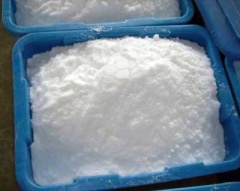Difference between revisions of "Argol"
| (One intermediate revision by the same user not shown) | |||
| Line 7: | Line 7: | ||
| risk factors = See text | | risk factors = See text | ||
}} | }} | ||
| + | __TOC__ | ||
==Description== | ==Description== | ||
[[Potassium Tartrate]], [[Dipotassium Tartrate]] or argol has formula K2C4H4O6. It is the potassium [[salt]] of tartaric acid. It is often confused with potassium bitartrate, also known as cream of tartar. As a food additive, it shares the E number E336 with potassium bitartrate.<br><br> | [[Potassium Tartrate]], [[Dipotassium Tartrate]] or argol has formula K2C4H4O6. It is the potassium [[salt]] of tartaric acid. It is often confused with potassium bitartrate, also known as cream of tartar. As a food additive, it shares the E number E336 with potassium bitartrate.<br><br> | ||
| − | [[Potassium | + | [[Potassium Tartrate]] is produced by the reaction of tartaric acid with potassium sodium tartrate (rochelle [[salt]]), and potassium sulfate, followed by filtration, purification, precipitation and drying.<br><br> |
Tartar emetic is produced when potassium tartrate is heated with antimony trioxide. Tartar emetic causes intense nausea, prostration and vomiting by irritating the gastrointestinal mucosa.<br><br> | Tartar emetic is produced when potassium tartrate is heated with antimony trioxide. Tartar emetic causes intense nausea, prostration and vomiting by irritating the gastrointestinal mucosa.<br><br> | ||
Argol is an impure form of potassium bitartrate, the deposit of fermented wines.<br><br> | Argol is an impure form of potassium bitartrate, the deposit of fermented wines.<br><br> | ||
Latest revision as of 10:48, 11 October 2012
| Infobox on Argol | |
|---|---|
| Example of Argol |  |
| Facts | |
| Origin | - |
| Stowage factor (in m3/t) | - |
| Humidity / moisture | - |
| Ventilation | - |
| Risk factors | See text |
Argol
Description
Potassium Tartrate, Dipotassium Tartrate or argol has formula K2C4H4O6. It is the potassium salt of tartaric acid. It is often confused with potassium bitartrate, also known as cream of tartar. As a food additive, it shares the E number E336 with potassium bitartrate.
Potassium Tartrate is produced by the reaction of tartaric acid with potassium sodium tartrate (rochelle salt), and potassium sulfate, followed by filtration, purification, precipitation and drying.
Tartar emetic is produced when potassium tartrate is heated with antimony trioxide. Tartar emetic causes intense nausea, prostration and vomiting by irritating the gastrointestinal mucosa.
Argol is an impure form of potassium bitartrate, the deposit of fermented wines.
Application
Used in the preparation of tartaric acid and cream of tartar, and sometimes for dyeing purposes.
Shipment / Storage / Risk factors
Packed in kegs or multi-wall paper bags.
Argol which has been damaged by water may lose part of its tartaric acid content.
A sample of the damaged argol should be tested to ascertain content, and a depreciation may be considered accordingly.











